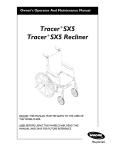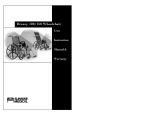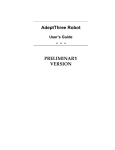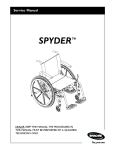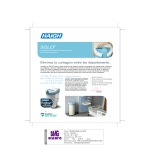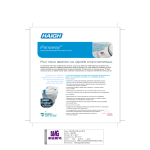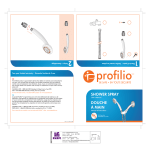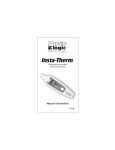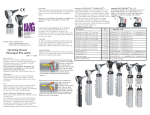Download Instructions
Transcript
Owner’s Manual Dealer: this manual must be given to the user of the wheelchair User: before using, read this manual and save for future reference AMG Medical Inc. Montreal, QC H4T 1V5 www.amgmedical.com MONTREAL AIRGO™ OWNER’S MANUAL TABLE OF CONTENTS 2 Table of contents . . . . . . . . . . . . . . . . . . . . . . . . . . . . . . . . . 2 Read before use. . . . . . . . . . . . . . . . . . . . . . . . . . . . . . . . . . 3 Choosing the right chair . . . . . . . . . . . . . . . . . . . . . . 3 Review this manual often . . . . . . . . . . . . . . . . . . . . . 3 Your Airgo™ wheelchair and it's parts . . . . . . . . . . . . . . . . 4 Airgo™ wheelchair specifications . . . . . . . . . . . . . . . . . . . 5 Basic safety precautions . . . . . . . . . . . . . . . . . . . . . . . . . . . 6 General warnings. . . . . . . . . . . . . . . . . . . . . . . . . . . . . . . 6-7 Safety / handling of wheelchair . . . . . . . . . . . . . . . . . . . . . 8 Folding and unfolding the wheelchair. . . . . . . . . . . . 8 Stability and balance . . . . . . . . . . . . . . . . . . . . . . . 8-9 Transferring . . . . . . . . . . . . . . . . . . . . . . . . . . . . . . . . 9 Tilting . . . . . . . . . . . . . . . . . . . . . . . . . . . . . . . . . . . . 9 Tilting - Ramps & inclines . . . . . . . . . . . . . . . . . . . 10 Maintenance. . . . . . . . . . . . . . . . . . . . . . . . . . . . . . . . . 11-13 Required tools . . . . . . . . . . . . . . . . . . . . . . . . . . . . . 13 Chair basics . . . . . . . . . . . . . . . . . . . . . . . . . . . . . . . . . 14-19 Installing the swing-away footrest . . . . . . . . . . . . . 14 Adjusting the swing-away footrest . . . . . . . . . . . . . 15 Installing the swing-away elevating leg rest . . . . . . 16 Adjusting the swing-away elevating leg rest. . . . . . 17 Adjusting armrest height . . . . . . . . . . . . . . . . . . . . 18 Removing 3-in-1 armrest and/or flip-back armrest. 18 Seat and back . . . . . . . . . . . . . . . . . . . . . . . . . . . . . . . . 19-20 Adjusting backrest height . . . . . . . . . . . . . . . . . . . . 19 Replacing the back upholstery . . . . . . . . . . . . . . . . 20 Replacing the seat upholstery . . . . . . . . . . . . . . . . . 20 NOTE: All illustrations and specifications in the manual are based on the latest product information available at the time of publication. AMG Medical Inc. reserves the right to make changes at any time, without notice. AMG Medical Inc • www.amgmedical.com Rear wheels . . . . . . . . . . . . . . . . . . . . . . . . . . . . . . . . . 21-22 Front casters . . . . . . . . . . . . . . . . . . . . . . . . . . . . . . . . . . . 23 Seat-to-floor height . . . . . . . . . . . . . . . . . . . . . . . . . . . . . . 24 Anti-tippers . . . . . . . . . . . . . . . . . . . . . . . . . . . . . . . . . . . . 25 Wheel locks. . . . . . . . . . . . . . . . . . . . . . . . . . . . . . . . . . . . 26 Limited warranty. . . . . . . . . . . . . . . . . . . . . . . . . . . . . . . . 27 AIRGO™ OWNER’S MANUAL READ BEFORE USE 3 A. CHOOSING THE RIGHT CHAIR Airgo™ offers many wheelchair accessories options and configurations to meet the needs of the individual user. However, the final selection of options, accessories and adjustments should be made together by you, with your health care advisor and/or Airgo™ dealer. Selecting the best Airgo™ wheelchair configuration depends on such things as: 1. Your level of physical strength, balance and coordination. 2. The types of hazards you must overcome in the environments in which you will use the wheelchair (home, work and other places you frequent regularly). 3. The options needed for your comfort and safety. B. REVIEW THIS MANUAL OFTEN Before using this wheelchair, you and each person who may assist you, should read this manual carefully and follow all instructions. Review the warnings and precautions often until you are fully familiarized with them. AMG Medical Inc • www.amgmedical.com AIRGO™ OWNER’S MANUAL AIRGO™ WHEELCHAIR AND PARTS 1. Padded backrest 2. Padded armrest 3. Wheel-lock 4. Padded seat 5. Swing-away footrest / elevating leg rest 6. Push handle grip 7. Rear wheel 8. Hand rim 9. Anti-tipper device 10. Side frame 11. Front fork 12. Front caster AMG Medical Inc • www.amgmedical.com 4 AIRGO™ OWNER’S MANUAL AIRGO™ WHEELCHAIR SPECIFICATIONS Seat width 16, 18, 20 or 22-inches Seat depth 16 or 18-inches Seat-to-floor 17 ¾ or 19 ¾ inches Overall width 23, 25, 27 or 29 inches Overall depth (without front rigging) 30 ½ inches or 32 ½ inches Back style Adjustable Back height 16, 17 & 18-inches in 1-inch increment Arm style Flip-back, detachable desk arm with height adjustment Flip-back, detachable full arm with height adjustment Flip back, detachable desk arm with fixed height Front rigging Swing-away Footrests and Elevating Leg rests Rear axle Dual Position Rear wheels 24” Polyurethane (PU) Airless or Pneumatic Hand rims Composite or Aluminium Wheel locks Pull to Lock Front casters 8” PU Solid or Pneumatic Upholstery Black Nylon Weight capacity The 16” and 18” seat width wheelchair models have a weight limitation of 250 lbs. (114 kg). The 20” and 22” seat width wheelchair models have a weight limitation of 350 lbs. (159 Kg). Limited warranty Limited Lifetime AMG Medical Inc • www.amgmedical.com 5 AIRGO™ OWNER’S MANUAL BASIC SAFETY PRECAUTIONS 6 Before using your wheelchair, please read and keep in mind the following safety precautions. Failure to do so could result in personal injury and/or damage to your wheelchair. • • • • • • • • • Before using, you should receive training in the safe use of a wheelchair from an authorized dealer and/or health care advisor. After engaging the wheel locks, practice bending, reaching and transferring, taking into account the limit of your abilities. NEVER try new manoeuvres on your own until you are sure you can do so safely. Familiarize yourself with the areas where you plan to use your wheelchair. Look for hazards and learn to how to avoid them. Use of anti-tippers is recommend for added safety. Ensure that the wheelchair rolls smoothly and that all parts are working properly. Check for noise, vibration or a change in ease of use. which may indicate loose fasteners, or damage to your wheelchair. Always consult an authorized Airgo™ dealer to find and correct any problems or if you have any doubt about the condition of your wheelchair. GENERAL WARNINGS • • • • AMG Medical Inc • www.amgmedical.com Do not exceed the weight limit listed on the product. The listed weight limit is for the combined weight of rider and all items carried. Exceeding the listed weight limit risks damage to the wheelchair, a fall, tip-over or loss of control which can cause severe injury to the user or others. Do not attempt to operate your wheelchair on roads, streets or highways. Do not operate your wheelchair in hilly or overly rough terrain, sandy, oily, wet or icy surfaces. Unauthorized modification of your wheelchair or the use of non-AMG replacement parts may change the AIRGO™ OWNER’S MANUAL GENERAL WARNINGS • • • • • • • • • • • • • • AMG Medical Inc • www.amgmedical.com 7 structure of the wheelchair and may cause a safety hazard and will void the warranty. Do not attempt ANY inclines or declines greater than 9°. Do not attempt inclines without anti-tippers installed Do not attempt to ride over curbs or obstacles. This may cause your wheelchair to tip over risking personal injury and/or a damage to your wheelchair. Do not use on an escalator. Serious injury may occur. Do not attempt to reach objects if you have to move forward in the seat. Do not lean over the top of the back upholstery. This will change your center of gravity and may cause your wheelchair to tip over risking personal injury and/or damage to your wheelchair. Do not try to pick up an object from the floor by reaching down between your knees. You are less likely to tip if you reach over the side of your chair. Wheelchair users should NOT be transported in a vehicle while in the wheelchair unless the vehicle is properly equipped to do so. Do not tie down or attach any thing to the wheels. This may cause your wheelchair to tip over risking personal injury and/or damage to your wheelchair. Do not stand or step on the footplates while transferring. Never lift your wheelchair by any of its detachable parts. WHEEL LOCKS ARE NOT BRAKES. Do not use the wheel locks to slow down or to stop your wheelchair while it is still moving. Always engage the wheel locks when transferring, resting or using a wheelchair lift. Check pneumatic tire pressure regularly to ensure proper air pressure. Failure to do so could result in the malfunction of the wheel locks, and may cause serious injury. AIRGO™ OWNER’S MANUAL SAFETY / HANDLING OF WHEELCHAIR 8 FOLDING AND UNFOLDING THE WHEELCHAIR WARNING: DO NOT place your hands or fingers between seat rail and side panel. DO NOT sit or transfer into the wheelchair unless it is fully open and the seat frame rails are fully seated into the frame saddles. Unfolding 1. Tilt the wheelchair toward you far enough to take the weight off the opposite wheel. 2. Push down on the top of the seat rail closet to you until the wheelchair is fully open. 3. Make sure seat rails are fully seated into frame saddles. Folding 1. Fold up the footplates and ensure that the swingaway footrests / leg rests are in locked position in front of the wheelchair. 2. Standing at one side of the chair, use both hands to grasp the middle of the seat upholstery at the front and back edge and lift up. 3. Standing at one side of the chair, use both hands to grasp the armrest furthest from you and pull the armrests towards you until the wheelchair folds. STABILITY AND BALANCE Your wheelchair has been designed and engineered to maintain balance during normal daily activity as long as you do not move beyond the center of gravity. To assure stability and proper operation of your wheelchair, you must at all times maintain proper balance. WARNING: DO NOT attempt to reach objects if you must move forward in the seat or if you must reach down between your knees. DO NOT shift your weight in the direction you are reaching. AMG Medical Inc • www.amgmedical.com Reaching, leaning and bending Although it is not recommended, you might occasionally lean, bend or reach while sitting in your wheelchair. Consult with your health care advisor and/or authorized dealer for assistance in developing safe techniques suited to your abilities and limitations. Forward or sideward 1. Operate the wheelchair as close as possible to the object you wish to reach. 2. Rotate the front casters fully forward. 3. Engage both wheel locks. AIRGO™ OWNER’S MANUAL SAFETY / HANDLING OF WHEELCHAIR WARNING: DO NOT lean over the top of the back upholstery. DO NOT engage the wheel locks. If you shift your weight while reaching, it is better to roll backwards than to tip over. WARNING: Before attempting a transfer, always engage both wheel locks. DO NOT step on the foot-plates, as this could cause the wheelchair to tip over. WARNING: DO NOT attempt to tilt your wheelchair without assistance. Tilting the wheelchair backward beyond its balance point can be dangerous and may result in injuries. AMG Medical Inc • www.amgmedical.com 9 Reaching, leaning and bending (contd.) Backward 1. Operate your wheelchair as close as possible to the object. 2. Rotate front casters fully forward. Reach only as far as your arm will extend without changing your sitting position. If in doubt, reposition the wheelchair or ask for help. TRANSFERRING 1. Position the wheelchair as closely as possible along side the seat to which you are transferring. 2. Remove or flip back the armrest. 3. Engage wheel locks. 4. Shift body weight into the seat with transfer. TILTING Tilting should only be performed with the assistance of an attendant. 1. Grasp the push handles securely and ensure that handgrips are firmly attached. 2. Make sure the occupant's feet are secure on the footplates and that arms, hands and fingers are clear of wheels and/or pinch points. 3. Advise the occupant prior to tilting the wheelchair backward. 4. Place one foot on the tipping lever (located on the rear bottom of the wheelchair) and apply downward force until the balance point is reached (approximately 30°). 5. Lower the front end slowly. AIRGO™ OWNER’S MANUAL SAFETY / HANDLING OF WHEELCHAIR 10 WARNING: DO NOT attempt inclines or declines without anti-tipper installed. DO NOT attempt any incline or decline of more than nine degrees. During decent, the lowest part of the footrest should be no closer to the ground than 2-1/2 inches to permit proper clearance. TILTING – RAMPS & INCLINES Ascent Lean the upper part of your body slightly forward as you propel up an incline. If it becomes necessary to stop, avoid any abrupt or sudden forward movement as this could cause tipping. WARNING: DO NOT allow the wheelchair to drop off the curb edge. DO NOT attempt to lift the wheelchair by any detachable armrest, leg rests or other removable parts. DO NOT attempt to step over a high curb without two attendants. ALWAYS check the hand grips to make sure that they are secure and are not rotating or slipping off. Curbs & steps NOTE - This should only be performed with the assistance of an attendant. Going up (method 1) 1. Tilt the wheelchair backward to its “balance point” and move forward until the front casters pass over the top of the curb or the step. 2. Lower the front casters slowly on top of the curb. 3. Lift the wheelchair and push it forward until the rear wheels roll up and over the curb. 4. Ensure the wheelchair is completely cleared of the curb and cannot roll backwards. Descent NOTE - This should only be performed with the assistance of an attendant. Always face forward when going down a ramp, but DO NOT lean forward as this could cause the wheelchair to tip. Leaning backward can increase the stability slightly. It is critical to keep the wheelchair under control at all times and to handle the wheelchair slowly. Going up (method 2) 1. Turn the wheelchair backward until the rear wheels are against the curb or step. 2. Tilt back to its “balance point” and pull up the wheelchair over the curb. 3. Lower down front casters only once the wheelchair is far enough from the edge of the curb. AMG Medical Inc • www.amgmedical.com AIRGO™ OWNER’S MANUAL SAFETY / HANDLING OF WHEELCHAIR 11 Curbs & steps (contd.) NOTE - This should only be performed with the assistance of an attendant. Going down 1. Turn the wheelchair backward and carefully step down to the next step. 2. Hold the wheelchair securely and pull the wheelchair to where the rear wheels reach the curb edge. 3. Slowly roll the rear wheels down onto the lower level. 4. Tilt back to its “balance point” and turn face forward. 5. Carefully lower the front casters by placing one foot on the tipping lever until the wheelchair is completely cleared of the curb/step. WARNING: Wheelchairs are especially prohibited on escalators. It is extremely dangerous and should never be attempted. Stairways Never use the wheelchair on stairs UNLESS you have someone to help you. Ramps or elevators are recommended. MAINTENANCE NOTE – Every six months take your wheelchair to a qualified dealer for a thorough inspection and servicing. Regular cleaning will reveal loose or worn parts and enhance the smooth operation of your wheelchair. To operate properly and safely, your wheelchair must be cared for just like any other vehicle. Routine maintenance will extend the life and efficiency of your wheelchair. Initial adjustments should be made to suit personal body structure and preference. AMG Medical Inc • www.amgmedical.com AIRGO™ OWNER’S MANUAL MAINTENANCE 12 Initially, all the following points should be checked. Thereafter we recommend that you follow these maintenance procedures: To check... Weekly Monthly Periodically General • Wheelchair rolls straight (no excess drag or pull to one side) Ö Ö Frame and crossbraces • Inspect for loose or missing hardware • Inspect for bent frame or cross braces Ö Ö Seat and back • Inspect for rips or sagging • Inspect for loose or broken hardware • Inspect cane hand grips for wear/looseness/deterioration Ö Ö Ö Rear wheels • Ö No excessive side movement when lifted and spun Hand rims • Ö Inspect for signs of rough edges or peeling Spokes • Inspect for broken spokes Ö Front casters / forks • Inspect axle assembly for proper tension by spinning caster. Caster should come to a gradual stop • Check hardware for tightness • Wheel bearings are clean and free of moisture Ö Ö Ö CAUTION: As with any vehicle, the wheels and tires should be Ö checked periodically for cracks and wear, and should be replaced. Tires • Inspect for cracks or wear • If pneumatic, check for proper inflation Ö Ö Ö CAUTION: As with any vehicle, the wheels and tires should be Ö checked periodically for cracks and wear, and should be replaced. Wheel locks • Do not interfere with tires when rolling • Pivot points free of wear and looseness • Wheel locks easy to engage • Wheel locks prevent wheelchair from moving when engaged AMG Medical Inc • www.amgmedical.com Ö Ö Ö Ö AIRGO™ OWNER’S MANUAL MAINTENANCE 13 Cleaning 1. Frame • Clean the frame with mild soap at least once a month. 2. Axle and Moving Parts • Clean the area around axles and moving parts periodically with a slightly damp (not wet) cloth. • Wipe off or blow away any fluff, or dirt on axles or moving parts. 3. Upholstery • Hand-wash. • Drip-dry only. Storage 1. Store your wheelchair in a clean, dry area. If you fail to do so, parts may rust or corrode. 2. If stored for more than three months, have your wheelchair inspected by an Airgo™ authorized dealer before using. REQUIRED TOOLS Allen keys: 4 mm and 6 mm Screw driver: Philips # 2 Socket wrenches: 8 mm, 10 mm, 13 mm, and 17 mm or 1 adjustable wrench AMG Medical Inc • www.amgmedical.com AIRGO™ OWNER’S MANUAL CHAIR BASICS 14 FRONT RIGGING WARNING: After ANY adjustments, repair or service and BEFORE use, make sure all attaching hardware is tightened securely otherwise injury or damage may result. Installing the swing-away footrest 1. Turn the footrest to the side (open footplate is perpendicular to wheelchair). 2. Install the hinge plates onto the hinge pins on the wheelchair frame. 3. Push the footrest towards the inside of the wheelchair until it locks into place. 4. Repeat STEPS 1-3 for the other footrest assembly. 5. To release the footrest, push the footrest release lever inward, rotate footrest assembly outward and lift the footrest assembly off the hinge pins. NOTE - The footplate will be on the inside of the wheelchair when locked in place. AMG Medical Inc • www.amgmedical.com AIRGO™ OWNER’S MANUAL CHAIR BASICS 15 Adjusting the swing-away footrest 1. Remove impact guards and/or calf strap, if necessary. 2. Loosen, but do not remove the bolt & locknut that secure the lower footrest sub-assembly to upper footrest support. 3. Reposition the lower footrest sub-assembly to the desired height. 4. Securely tighten the bolt & locknut. 5. Repeat STEPS 1- 4 for the other footrest, if necessary. 6. Replace impact guards and/or calf strap, if necessary. 7. Reinstall the swing-away footrest assembly. AMG Medical Inc • www.amgmedical.com AIRGO™ OWNER’S MANUAL CHAIR BASICS 16 Installing the swing-away elevating leg rest 1. Place the elevating leg rest assembly on the outside of the wheelchair and install the hinge plates onto the hinge pins on the wheelchair frame. 2. Rotate leg rest assembly toward the inside of the wheelchair until it locks in place. 3. Repeat STEPS 1-2 for the other leg rest assembly. NOTE - The footplate will be on the inside of the wheelchair when the leg rest is locked in place. 4. After seated in wheelchair, adjust the footrest to correct height by loosening the locknut and sliding the lower footrest tube up or down until desired height is achieved. 5. Tighten locknut securely. 6. To release the leg rest, push the leg rest release handle toward the inside of the wheelchair (facing the front of the wheelchair) and swing the leg rest assembly to the outside of the wheelchair. AMG Medical Inc • www.amgmedical.com AIRGO™ OWNER’S MANUAL CHAIR BASICS 17 Adjusting the swing-away elevating leg rest 1. To adjust the elevating leg rest, raise legs until the desired height is obtained. 2. To reposition leg rest to normal position, support leg with one hand and push release handle downward with the other hand. 3. To adjust the calf pad, turn the pad towards the outside of the wheelchair. 4. Slide the calf pad up or down until the desired position is obtained. 5. To secure the calf pad, turn the calf pad towards the inside of the wheelchair. AMG Medical Inc • www.amgmedical.com AIRGO™ OWNER’S MANUAL CHAIR BASICS 18 WARNING: After ANY adjustments, repair or service and BEFORE use, make sure all attaching hardware is tightened securely otherwise injury or damage may result. Adjusting armrest height WARNING: Make sure the height adjustment knob is securely in locked position BEFORE using the wheelchair. 1. Unlock the armrest by pulling the height adjustment knob horizontally. 2. Slide armrest up or down until the desired position is obtained. 3. Lock the armrest by releasing the height adjustment knob and having knob end positioned into key seat of the armrest. 4. Repeat STEPS 1-3 for other armrest. Removing 3-in-1 armrest and/or flip-back armrest WARNING: Make sure the armrest is securely locked BEFORE using the wheelchair. AMG Medical Inc • www.amgmedical.com 1. 2. 3. 4. Press the flip-back release lever located on the armrest. Flip the armrest back. Pull the rear knob and remove the armrest. To install the armrest, reverse above procedure. AIRGO™ OWNER’S MANUAL CHAIR BASICS WARNING: After ANY adjustments, repair or service and BEFORE use, make sure all attaching hardware is tightened securely- otherwise injury or damage may result. SEAT AND BACK Adjusting backrest height BOLT 1. Remove the knob and bolt from both sides. 2. Slide backrest up and down to the desired height. 3. Securely tighten the screw and knob on both sides AMG Medical Inc • www.amgmedical.com 19 AIRGO™ OWNER’S MANUAL CHAIR BASICS 20 Replacing the back upholstery BACK CANES KNOB & SCREW 1. Remove the knob and bolt on both sides. 2. Pull the back cane off the wheelchair frame. 3. Remove the four (4) mounting screws and washers that secure the existing back upholstery to the back canes. 4. Pull the existing back upholstery off the back cane. 5. Install the NEW back upholstery over the back canes. 6. Secure the NEW back upholstery to the back canes with the existing mounting screws and washers. 7. Secure the back cane to the wheelchair frame with knob and bolt. AMG Medical Inc • www.amgmedical.com AIRGO™ OWNER’S MANUAL CHAIR BASICS 21 Replacing the seat upholstery 1. Remove the eight screws & washers (16” depth) or ten screws & washers (18” depth) that secure seat upholstery to the cross braces. 2. Remove the existing seat upholstery from the rails of the cross braces. 3. Install the new upholstery by reversing above procedure. REAR WHEELS WARNING: After ANY adjustments, repair or service and BEFORE use, make sure all attaching hardware is tightened securely - otherwise injury or damage may result. Removing / installing rear wheels 1. For 16” & 18” frames, remove the hub cap, locknut and hex bolt that secures the rear wheel to the wheelchair. 2. Repeat STEP 1 for the other rear wheel. 3. To reinstall the rear wheel onto the wheelchair, reverse step 1 of the above procedure. AMG Medical Inc • www.amgmedical.com AIRGO™ OWNER’S MANUAL REAR WHEELS 22 Replacing rear wheel hand rim WARNING: Replacement of rear wheel tire or tube must be performed by a qualified technician. CAUTION: As with any vehicle, the wheels and tires should be checked periodically for cracks and wear, and should be replaced. AMG Medical Inc • www.amgmedical.com 1. Remove the rear wheel from the wheelchair. 2. For a composite hand rim, remove the screws & washers that secure the hand rim to the rear wheel. For an aluminium hand rim, remove the screws, washers and spacers that secure the hand rim to the rear wheel. 3. Remove the existing hand rim. 4. To install the new hand rim, reverse above procedures. 5. Repeat STEPS 1-3 for the other rear wheel if necessary. AIRGO™ OWNER’S MANUAL FRONT CASTERS WARNING: After ANY adjustments, repair or service and BEFORE use, make sure all attaching hardware is tightened securely - otherwise injury or damage may result. 23 Installing/replacing front casters and forks 1. Remove the fork cap. 2. Remove the locknut that secures the fork stem to the caster head tube. 3. Drop the front caster and fork out of the caster head tube. WARNING: Replacement of the front caster must be performed by a qualified technician. Replacing/repairing front caster CAUTION: As with any vehicle, the wheels and tires should be checked periodically for cracks and wear, and should be replaced. 1. Remove the bolt, spacers and locknuts that secure the front caster to the fork. 2. Install the new front caster onto the wheelchair and replace the bolt, spacer and locknuts as before. 3. Repeat STEPS 1-2 for the other front caster if necessary. AMG Medical Inc • www.amgmedical.com AIRGO™ OWNER’S MANUAL SEAT-TO-FLOOR HEIGHT 24 WARNING: After ANY adjustments, repair or service and BEFORE use, make sure all attaching hardware is tightened securely - otherwise injury or damage may result. Changing seat-to-floor height NOTE – The manufacturer recommends that the following procedure be performed by an authorized dealer or by a qualified technician. 1. Remove the rear wheels from the wheelchair. Refer to REMOVING/INSTALING THE REAR WHEELS in the “REAR WHEELS” section of this manual. 2. Remove the front casters from the wheelchair. Refer to INSTALLING/REPLACING FRONT CASTERS AND FORKS in the “FRONT CASTERS” section of this manual. 3a. To obtain a 17 3/4” seat-to-floor height, mount the front caster at the TOP position and the mount the 24” rear wheel also at the TOP position. 3b. To obtain a 19 3/4” seat-to-floor height, mount the front caster at the BOTTOM position and the mount the 24” rear wheel also at the BOTTOM position. 4. Reinstall the front casters onto the wheelchair. Refer to INSTALLING/REPLACING FRONT CASTERS AND FORKS in the “FRONT CASTERS” section of this manual. 5. Reinstall the rear wheels onto the wheelchair. Refer to REMOVING/INSTALLING THE REAR WHEELS in the “REAR WHEELS” section of this manual. 6. Adjust anti-tippers according to NEW seat-to-floor height. Refer to ADJUSTING ANTI-TIPPERS HEIGHT in the “ANTI-TIPPERS” section of this manual (next page). WARNING: When changing the seat-tofloor height, the height of the anti-tippers must be adjusted accordingly. AMG Medical Inc • www.amgmedical.com AIRGO™ OWNER’S MANUAL ANTI-TIPPERS WARNING: After ANY adjustments, repair or service and BEFORE use, make sure all attaching hardware is tightened securely - otherwise injury or damage may result. Anti-tippers MUST be fully engaged. 25 NOTE – Anti-tippers are strongly recommended as an additional safeguard for the wheelchair user. Installing anti-tippers PLUG LOCATION WARNING: Ensure that the release button of the anti-tipper fully protrudes out of the hole on the bottom of the wheelchair frame. Ensure both antitippers are adjusted to the same height. 1. Remove plug (not shown) from the end of rear frame tubing. 2. Press the release button in and insert the anti-tippers with the anti-tipper wheels pointing toward the ground/floor into the rear frame tubing until the release button locks in place. 3. Measure the distance between the bottom of the antitipper wheels and the ground/floor. NOTE: A 1-1/2 to 2- inch clearance between the bottom of the anti-tipper wheels and the ground/floor MUST be maintained at all times. 4. If the distance between the bottom of anti-tipper wheels and the ground/floor is not 1-1/2 to 2-inches, adjust anti-tippers (see below). Adjusting anti-tippers height 1. Press the release adjustment buttons on the wheeled portion of the anti-tipper and slide it up or down to achieve the 1-1/2 to 2-inches clearance. 2. Check to make sure that the release buttons are fully engaged in adjustment holes. AMG Medical Inc • www.amgmedical.com AIRGO™ OWNER’S MANUAL WHEEL LOCKS WARNING: After ANY adjustments, repair or service and BEFORE use, make sure all attaching hardware is tightened securely - otherwise injury or damage may result. 26 NOTE – Before adjusting or replacing the wheel-lock subassemblies, ensure that the pneumatic tires are inflated to the recommended 45 – 50 PSI (3.1 – 3.4 atm) on the sidewall of the tire. 1/4” - 13/32” (6.4 - 10.3 mm) 1. Ensure the wheel-lock is in the open (unlocked) position. 2. Loosen the bolt and locknut that secure the wheel-lock to the wheelchair frame. 3. Adjust the position of wheel-lock until the measurement between the rear wheel and the wheellock shoe is between 1/4 and 13/32 inches. 4. Securely tighten the bolt and locknut. 5. Engage the wheel-lock and push against the wheelchair to determine if wheel-lock engages the wheel-lock shoe enough to hold the wheelchair. 6. Repeat the above procedures until the wheel-lock holds the wheelchair. AMG Medical Inc • www.amgmedical.com AIRGO™ OWNER’S MANUAL LIMITED WARRANTY 27 Warranty period. Three year warranty on the side frame and "X" brace of the wheelchairs. Six month warranty is offered on all other metal parts. Upholstery, plastic, and rubber parts are warranted for three months. The warranty period for the consumer begins on the date of purchase from the dealer. If the product is not sold to the consumer, but is rented, etc., the warranty period commences on the invoice date. Limitations: This warranty covers only defects in material and workmanship. Products subjected to improper maintenance, improper transport, negligence, abuse or misuse are not covered by this warranty. If the serial number is removed or defaced, the wheelchair will not be covered by this warranty. If the wheelchair has been structurally altered or equipped with parts not distributed by AMG Medical Inc., the wheelchair will not be covered by this warranty. This warranty applies only to the original purchaser. If you want to claim warranty service, contact the store where you purchased the chair, who will notify AMG, to determine the proper course of action to take, or call 1-800-363-2381. All products shipped to AMG for warranty service must have prior authorization from AMG Medical Inc.. Please ensure you provide us with the following information when you call: Date of Purchase:____________ Serial Number (located on crossbrace) :________________ Once you have a return authorization number, the unit should be shipped prepaid to: AMG Medical Inc., 8505 Dalton, Montreal, QC H4T 1V5 Include a copy of the original bill of sale and a money order of $10.00 to cover cost of insurance and return transportation. AMG Medical Inc • www.amgmedical.com AMG Medical Inc. Montreal, QC H4T 1V5 www.amgmedical.com REV. 2 0104 MONTREAL





























